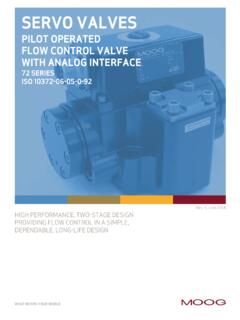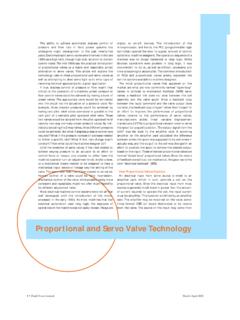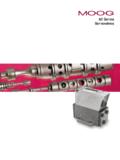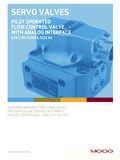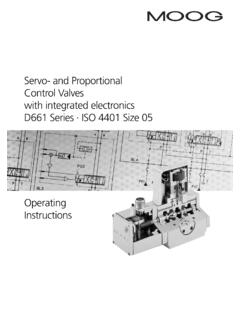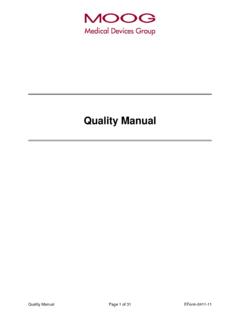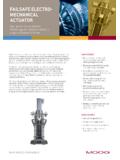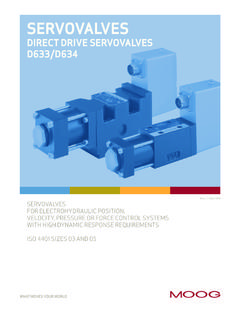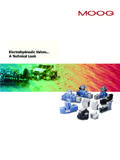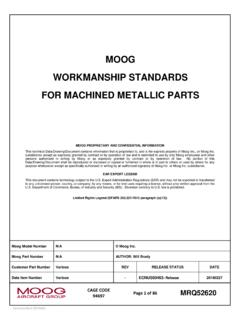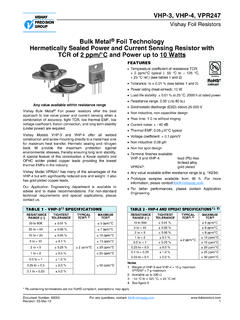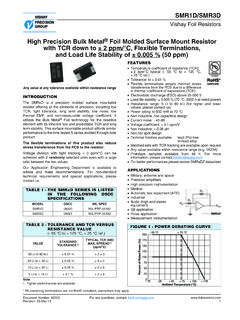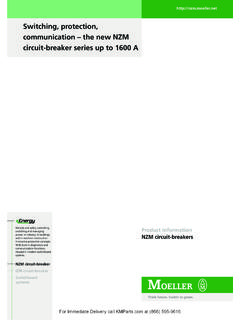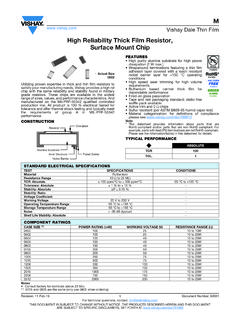Transcription of Application Information - Moog Inc.
1 Application Information moog Components group manufactures a comprehensive line of brush-type and brushless motors, as well as brushless controllers. The purpose of this document is to provide a guide for the selection and Application of DC motors and controllers. This document is not intended to be a design guide. The terms presented herein are simple and straightforward; the calculations are simiplified but accurate. If more Information is necessary, an applications engineer will be happy to answer any question or address any concern that may arise. applications - WHAT TO CONSIDER. It is safe to say that no two applications are exactly the same. An apparatus that spins a pulley or fan is much different from one that precisely positions a workpiece or cutting tool.
2 Regardless of how simple or complex the Application , there are common requirements to consideration for the selection of the proper motor and / or controller. Some common considerations are: (presented here in the form of questions). What output torque is required? Motor torque is a combination of the internal torque losses TF (a function of motor design) and external torque load TL. External torque load is a function of load inertia and load acceleration. This will be covered later. What speed range is required? How fast should the motor run when loaded and unloaded? What space is available for the motor? What length motor is required? What is the maximum motor diameter? Motor dimensions may be dictated by performance requirements.
3 What is the source of power for the motor? Is the source AC or DC? What are the current limits of the source? What is the voltage range of the source? Is there any special shaft and / or mounting requirements? Does the shaft need a flat or a keyway? What length and diameter does the shaft need to be? Is a rear shaft extension required? (rear shaft extensions are necessary when encoders, brakes, etc. are added). Are there any environmental considerations? Environmental considerations include: Temperature Altitude Humidity Presence of chemicals, contaminants, vapors, etc. Shock and vibration Is the motor Heat Sinked ? A motor can be heat sinked by mounting it on a mass of thermally conductive material. The material conducts heat away from the motor.
4 Heat sinking has a dramatic effect on motor performance. Effective heat sinking increases the continuous output torque capability of the motor. What are the expected shaft axial and radial loads? What is the expected velocity profile? A velocity profile is a graph that shows how quickly the motor accelerates to rated speed, the time the motor runs at rated speed, and how quickly the motor decelerates to zero speed. Motor Terminology Motor terminology can be confusing; especially all those darn subscripts (KT, KE, TF, RT, etc.) This section will define some basic motor terms as well as the more common subscripts. The units associated with the subscripts are also presented (both standard and metric). 1. Terminal Voltage the voltage applied to the terminals of a motor.
5 2. Peak Torque the maximum torque a motor can produce for short periods of time, before irreversible demagnetization of the motor's magnets occurs. In smaller motors with higher resistance, the impedance of the motor often limits the peak torque. 3. Rated (Continuous) Torque the maximum torque, at rated speed, the motor can produce on a continuous basis, without exceeding the thermal rating of the motor. 4. Continuous Stall Torque the maximum torque, at zero speed, the motor can produce without exceeding its thermal rating. 5. Rated Current the approximate amount of current the motor will draw at its rated torque point. 6. Rated Speed the approximate motor speed at its rated torque point. 7. Rated Power the maximum output power the motor can produce without exceeding its thermal rating.
6 (output power is a function of speed and torque). 8. Torque Sensitivity the relationship of output torque to the input current of the motor. 9. Back EMF This is the ratio of generated output voltage to driven speed. (Also referred to as CEMF counter-electromotive force or generator voltage.). 10. Terminal Resistance (Brushless DC Motors) static line to line resistance @ 25 deg. C. 11. Terminal Resistance (Brush-Type DC Motors) dynamic resistance of the armature, brushes, and lead wires at a predetermined current @ 25. deg. C. 12. Friction Torque the amount of torque required to overcome a motor's static friction. Bearings, brushes, shaft seals, etc. all introduce friction into the motor. 13. Thermal Resistance the ratio of a motor's temperature rise to the motor's power loss 14.
7 Motor Constant the ratio of a motor's output torque to the motor's input power. Motor constant is a figure of merit commonly used to compare motor capability. 15. Speed / Torque Gradient - the negative slope of the speed / torque line measured in rpm / oz-in. moog Components group 221 221. Application Information Common Subscripts Subscript Parameter Units (English) Units (SI). TC Continuous Torque oz-in Nm TPK Peak Torque oz-in Nm TCS Continuous Stall Torque oz-in Nm TF Friction Torque oz-in Nm IC Continuous Current amps amps IPK Peak Current amps amps Nnl No-Load Speed rpm rad / s PT Rated Power watts watts VT Terminal Voltage volts volts EG Generator Voltage volts volts PI Input Power watts watts PO Output Power watts watts KT Torque Constant oz-in / amp Nm / amp KE Back EMF Constant v / krpm volts per rad / s KM Motor Constant oz-in / w Nm / w RT Terminal Resistance ohms ohms LT Terminal Inductance millihenries millihenries JR Rotor Inertia oz-in-s 2.
8 Gram-cm2. RTH Thermal Resistivity C / watt C / watt Conversions for some of the more commonly used motor parameters are: KT Torque Constant 1 Nm / amp = oz-in / amp 1 oz-in / amp = x 10-3 Nm / amp KE Back EMF Constant 1 v / krpm = x 10-3 volt per rad / s 1 volt per rad / s = v / krpm KM Motor Constant 1 oz-in / w = x 10-3 Nm / w 1 Nm / w = oz-in / w JR Rotor Inertia 1 oz-in-s2 = x 104 gm-cm2. 1 gm-cm2 = x 10-5 oz-in-s2. Basic Motor Theory Permanent magnet DC motors convert electrical energy into mechanical energy. This conversion takes place due to the interaction of the motor's two magnet fields. One of these magnetic fields is created by a set of permanent magnets (on the brush-type motor, the stator usually contains the permanent magnets; the brushless motor's magnets are a part of the rotor assembly).
9 The other magnetic field is created by current flowing through the motor's windings (the windings of a brush-type motor are contained in the armature (rotor), while the brushless windings are part of the stator assembly. In general, the stator is the stationary member of the motor, while the rotor is the rotating portion of the motor. The interaction of these two fields causes a resulting torque; the result of which is motor rotation. As the rotor turns, the current in the windings is commutated, resulting in a continuous torque output. (brush-type motors are mechanically commutated, while brushless motors are electronically commutated), Three basic concepts must be understood when examining basic motor operation. These concepts are: 1.)
10 Torque Torque, also known as a moment of force, is a measure of the twisting effect that produces rotation about an axis. Simply stated mathematically, torque is the product of a force and the perpendicular distance from the pivot point to the force vector, or T=FxD. Typical units of torque are Nm, oz-in, ft-lbs, etc. The torque produced by a PO = T x S / 1352 (units: watts; oz-in, rpm) motor is the sum of internal torque losses (friction and windage commonly labeled TF) the external load torque (TL). In a motor, the output torque is a function of the magnetic circuit, the number of magnet poles, and the number and configuration of the winding conductors. One of the two most important constants is that of torque sensitivity, or the torque constant ( KT).
